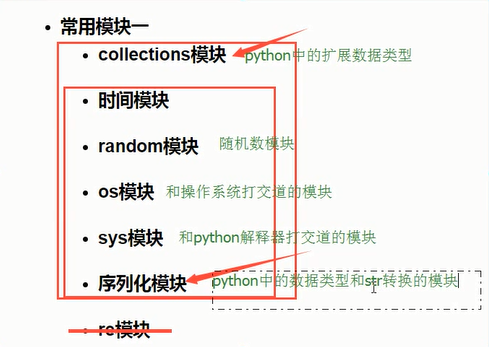python-day19_time_OS等模块

1,
#列表、元祖
#字典
#集合、frozenset
#字符串
#堆栈 : 先进后出
#队列 :先进先出 FIFO
# from collections import namedtuple
# Point = namedtuple('point',['x','y','z'])
# p1 = Point(1,2,3)
# p2 = Point(3,2,1)
# print(p1.x)
# print(p1.y)
# print(p1,p2)
#花色和数字
# Card = namedtuple('card',['suits','number'])
# c1 = Card('红桃',2)
# print(c1)
# print(c1.number)
# print(c1.suits)
#队列
# import queue
# q = queue.Queue()
# q.put([1,2,3])
# q.put(5)
# q.put(6)
# print(q)
# print(q.get())
# print(q.get())
# print(q.get())
# print(q.get()) # 队列取完后,再取时,程序阻塞
# print(q.qsize())
# from collections import deque #双端口队列,从队列前后2个端口进行取放
# dq = deque([1,2])
# dq.append('a') # 从后面放数据 [1,2,'a']
# dq.appendleft('b') # 从前面放数据 ['b',1,2,'a']
# dq.insert(2,3) #['b',1,3,2,'a']
# print(dq.pop()) # 从后面取数据
# print(dq.pop()) # 从后面取数据
# print(dq.popleft()) # 从前面取数据
# print(dq)
2,
#有序字典
# from collections import OrderedDict
# od = OrderedDict([('a', 1), ('b', 2), ('c', 3)])
# print(od) # OrderedDict的Key是有序的
# print(od['a'])
# for k in od:
# print(k)
# from collections import defaultdict
# d = defaultdict(lambda : 5)
# print(d['k'])
3,
# 格式化时间 —— 字符串: 给人看的
# 时间戳时间 —— float时间 : 计算机看的
# 结构化时间 —— 元祖 :计算用的
表示时间的三种方式
在Python中,通常有这三种方式来表示时间:时间戳、元组(struct_time)、格式化的时间字符串:
(1)时间戳(timestamp) :通常来说,时间戳表示的是从1970年1月1日00:00:00开始按秒计算的偏移量。我们运行“type(time.time())”,返回的是float类型。
(2)格式化的时间字符串(Format String): ‘1999-12-06’

%y 两位数的年份表示(00-99) %Y 四位数的年份表示(000-9999) %m 月份(01-12) %d 月内中的一天(0-31) %H 24小时制小时数(0-23) %I 12小时制小时数(01-12) %M 分钟数(00=59) %S 秒(00-59) %a 本地简化星期名称 %A 本地完整星期名称 %b 本地简化的月份名称 %B 本地完整的月份名称 %c 本地相应的日期表示和时间表示 %j 年内的一天(001-366) %p 本地A.M.或P.M.的等价符 %U 一年中的星期数(00-53)星期天为星期的开始 %w 星期(0-6),星期天为星期的开始 %W 一年中的星期数(00-53)星期一为星期的开始 %x 本地相应的日期表示 %X 本地相应的时间表示 %Z 当前时区的名称 %% %号本身
(3)元组(struct_time) :struct_time元组共有9个元素共九个元素:(年,月,日,时,分,秒,一年中第几周,一年中第几天等)
| 索引(Index) | 属性(Attribute) | 值(Values) |
|---|---|---|
| 0 | tm_year(年) | 比如2011 |
| 1 | tm_mon(月) | 1 - 12 |
| 2 | tm_mday(日) | 1 - 31 |
| 3 | tm_hour(时) | 0 - 23 |
| 4 | tm_min(分) | 0 - 59 |
| 5 | tm_sec(秒) | 0 - 60 |
| 6 | tm_wday(weekday) | 0 - 6(0表示周一) |
| 7 | tm_yday(一年中的第几天) | 1 - 366 |
| 8 | tm_isdst(是否是夏令时) | 默认为0 |
几种格式之间的转换

#时间戳,秒为单位,自1970年1月1日00:00:00以来经历了多少秒
>>>time.time()
1500875844.800804
#时间元组: localtime将一个时间戳转换为当前时区的struct_time
print(time.localtime()) # 可传参数值为秒的值
#输出:time.struct_time(tm_year=2017, tm_mon=7, tm_mday=24,
tm_hour=13, tm_min=59, tm_sec=37,
tm_wday=0, tm_yday=205, tm_isdst=0)
#时间字符串
time.strftime("%Y-%m-%d %H-%M-%S",date_touple)
>>>time.strftime("%Y-%m-%d %X")
'2017-07-24 13:54:37'
>>>time.strftime("%Y-%m-%d %H-%M-%S")
'2017-07-24 13-55-04'
# t = time.time()
# print(t)
# print(time.localtime(3000000000))
# print(time.gmtime(t))

import time # timestamp >> struct_time >> format string mytime = 400000000 struc_str = time.gmtime() # 格林威治时间 print(struc_str) struc_str1 = time.gmtime(mytime) # 按格林威治标准时间计算 print(struc_str1) struc_str2 = time.localtime(mytime) # 按北京时间,会自动+8。推荐 print(struc_str2) format_str = time.strftime('%Y-%m-%d %H:%M:%S',struc_str2) print(format_str) # 1982-09-04 23:06:40 # format string >> struct_time >> timestamp format_str = '1982-09-04 23:06:40' struc_str = time.strptime(format_str,'%Y-%m-%d %H:%M:%S') print(struc_str) mytime = time.mktime(struc_str) print(mytime) # 400000000.0
4,随机数
>>> import random #随机小数 >>> random.random() # 大于0且小于1之间的小数 0.7664338663654585 >>> random.uniform(1,3) #大于1小于3的小数 1.6270147180533838
#恒富:发红包 #随机整数 >>> random.randint(1,5) # 大于等于1且小于等于5之间的整数 >>> random.randrange(1,10,2) # 大于等于1且小于10之间的奇数 #随机选择一个返回 >>> random.choice([1,'23',[4,5]]) # #1或者23或者[4,5] #随机选择多个返回,返回的个数为函数的第二个参数 >>> random.sample([1,'23',[4,5]],2) # #列表元素任意2个组合 [[4, 5], '23']
#打乱列表顺序
>>> item=[1,3,5,7,9] >>> random.shuffle(item) # 打乱次序
5,OS模块
# os.system("dir") #执行操作系统下的命令
# ret = os.popen("dir").read()
# print(ret)
ret = sys.argv #在操作系统终端界面操作用,可用于给python程序传参数
name = ret[1]
pwd = ret[2]
if name == 'alex' and pwd == 'alex3714':
print('登陆成功')
else:
print("错误的用户名和密码")
sys.exit()
print('你可以使用计算器了')

import time old_time = time.mktime(time.strptime('1986-11-07 07:20:00','%Y-%m-%d %H:%M:%S')) # 时间戳,单位秒 now = time.time() now_format = time.strftime('%Y-%m-%d %H:%M:%S',time.localtime(now)) vv = now - old_time struct_time = time.localtime(vv) print('-从{}开始,到现在{}-'.format(time.strftime('%Y-%m-%d %H:%M:%S',time.localtime(old_time)),now_format)) print('共经历了:{}年{}月{}日 {}:{}:{}'.format(struct_time.tm_year-1970,struct_time.tm_mon-1, struct_time.tm_mday-1,struct_time.tm_hour,struct_time.tm_min, struct_time.tm_sec))

# import random # li = [] # for i in range(4): # check_num1 = str(random.randrange(0, 9)) # check_num2 = chr(random.randrange(65, 90)) # li.append(random.choice([check_num1,check_num2])) # result = ''.join(li) # print(result)


